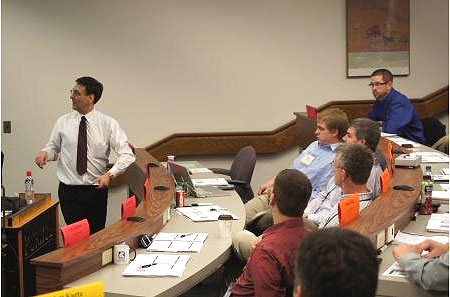Alexandria, Virginia, USA
March 23, 2012
More than 40 seed industry representatives came together March 5-10, 2012, for the American Seed Trade Association's 25th Management Academy, hosted by Purdue University's Center for Food and Agricultural business, to learn about the key factors that drive business decisions.
One of the topics presented by Frank Dooley, Purdue agricultural economist and provost fellow, led ASTA participants to think about the ins and outs of supply chain management including how it drives competitiveness, the system costs of inventory, and the relationship between cash conversion cycles and supply chain management.

Purdue's Frank Dooley, ag economist and provost fellow, discusses supply chain management analysis with more than 40 seed industry representatives and suppliers during ASTA's 25th Management Academy.
Dooley explained that the ability to manage tradeoffs is at the heart of supply chain management.
"Supply chain management is often not seen at the same level as marketing, finance and operations in many companies," he said. "Each of these areas has different values resulting in different requests from their respective leaders.
"For example marketing leaders tend to want to keep more inventory on hand while finance leaders will want less inventory, and marketing leaders want fast order processing versus finance's request for cheap order processing."
The drive to improve customer responsiveness should be tendered with more complex goals in the overall profitability equation, he said. This means that the supply chain manager must understand how service levels impact price negotiations, customer relationships, store inventories and even customer brand preference, Dooley shared.
In looking at inventory management, Dooley said it's a careful balancing act between stock availability and the cost of holding inventory.
"Awareness surrounding the importance of inventory management is increasing, but few really understand how it affects cost and customer service," he said. "In a perfect world, units ordered would match units sold, but we don't live in a perfect world.
"We have glitches in production and delivery, forecasting errors, changing customers, product proliferation and shorter product lifecycles."
Academy participants were asked to analyze profits and losses when overstocking occurred at different rates, as well as stocking out with an added penalty cost for running out. They looked at whether a company would lose more by running out than by overstocking.
"The stockout cost is probably the most important number that we ought to be thinking about when it comes to supply chain analysis," Dooley said.
He explained to participants that they can get a better idea of what to do if they have a sense of their demand distribution. Know what it costs to stock out and know what it costs to have excess inventory.
Not only do supply chain analysts need to look at the costs of over- and under-stocking, but also cash conversion cycles, Dooley noted.
Cash conversion cycle is the time it takes for a business to convert raw materials into finished goods, finished goods into sales and accounts receivable into cash.
"This varies by industry type and scale of production, as well as with seasonality and the rise and fall of sales," Dooley said. "Options for supply chain managers to influence the cash conversion cycle include decreasing the average days of inventory by increasing inventory turnover, decreasing time in accounts receivable by using electronic funds transfers to speed collections and/or delay payment to suppliers."
Dooley noted that typically for the agriculture input supply sectors, the conversion cycle tends to be very long due to the industry's seasonality and scale of production. To help put it in perspective, Dooley compared the seed industry's estimated 200- to 300-day conversion cycle to Walmart's cycle, which is about 20 days. He said risks and costs are much higher with newer products, but so are the returns.
"Excess inventory in the seed industry 'may' be a good idea," Dooley said.
In closing he said, "Seed companies must determine if high service or low cost is more important and that leaders within the companies must learn to accept uncertainty because of product turnover, moving in and out of the marketplace."
The other idea he left participants with is that stockout costs may and should be different for new seed versus mature and low margin seed.
"These values will differ, depending on the product you are dealing with," Dooley said.